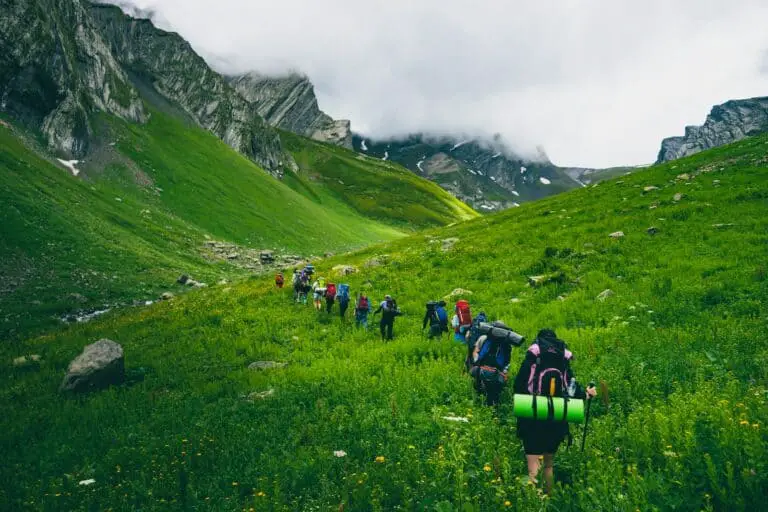When hiking who has the right of way? It’s not always clear-cut. In this article, we’ll delve into the unspoken rules of the trail, helping you navigate those narrow paths with confidence.
Understanding trail etiquette is crucial for every hiker. Not only does it ensure everyone’s safety, but it also makes the hiking experience more enjoyable for all. We’ll discuss who should yield to whom, when, and why.
The Importance of Understanding Trail Etiquette

Trail etiquette isn’t just about politeness — it’s about safety, respect, and ensuring everyone can enjoy their outdoor adventure. So, let’s talk about what makes it so important.
Firstly, trailed engagements. Trails aren’t as wide as sidewalks. When you encounter other hikers, it’s vital you know how to navigate the situation without causing any inconvenience. Whether you’re passing or being passed, understanding these unspoken rules can help maintain a smooth flow of traffic on the trails.
Secondly, respect for nature. When we choose to explore the great outdoors, we naturally take up the responsibility to preserve it. By obeying signage and staying on marked trails, we not only ensure our safety but also protect the natural habitats of trail-dwelling animals. A key aspect of trail etiquette is not to leave any trash or human-made products, which could harm the local wildlife.
Finally, maintaining harmony among trail users. Trails aren’t only for hikers — they’re also used by bikers, horse riders, bird watchers and more. Misunderstandings might happen, especially when one group is unaware of the others’ customs or rules. Learning about trail etiquette provides us with the knowledge needed to prevent these situations from escalating.
Following these unspoken norms goes beyond good manners. It’s about ensuring that everyone can enjoy their time on the trail. Whether you’re an experienced hiker or new to the trails, it’s crucial to remember we’re all in this together.
Now that we’ve emphasized the importance of trail etiquette, in the next section, we’re going to explore who should yield to whom, when, and why. Gathering this knowledge will certainly improve your hiking experience.
Rules of the Trail: Who Has the Right of Way?
Navigating trails isn’t just about choosing the path less trodden. It’s about understanding the essentials of trail etiquette. When two parties meet, who should yield to whom?
Hikers vs. Hikers
When two hiking parties meet head-on in a narrow trail, it’s common courtesy for the group moving downhill to step aside. The logic? Hikers heading uphill may be in a challenging rhythm or zone that can be harder to regain after stopping.
Hikers vs. Bikers
In most scenarios, bikers should yield to hikers. That’s due to the speed and maneuverability of a bike compared to a person on foot. However, don’t expect bikers to always have the chance to get out of the way promptly, especially on steep or winding sections. Safety first!
All vs. Equestrians
Horses, compared to bikers and hikers, are the VIPs on the trail. That means walkers, runners, and bikers should all yield to horseback riders. When a horse is approaching, move off the trail on the downhill side and avoid abrupt movements.
Note Exceptions
I should mention that rules can flip in specific scenarios. For instance, on a steep trail, it may not be safe or possible for bikers or horse riders to yield to downhill hikers. Knowledge of local trail rules and common sense can help fill in the gaps.
Remember, prioritizing safety and respect in shared outdoor spaces fuels everyone’s enjoyment. The way we use trails today shapes them for the hikers, bikers, and riders of tomorrow.
Who Should Yield to Whom?

There’s a balance that needs to be struck in the great outdoors. Trail etiquette is a must-know for hikers, bikers, and horseback riders. It’s not always as simple as it seems.
Hiking is one of those activities where momentum is everything. If two hiking parties meet on a narrow trail, the norm requires that the group moving downhill yield to the uphill hikers. It’s a basic courtesy, allowing uphill hikers to maintain their rhythm is essential.
In most cases bikers should yield to hikers. The reason is simple – they generally have higher speed and maneuverability. But trails can be unpredictable. Towers, steep inclines, sharp turns. During such challenges, bikers may not have the opportunity to yield promptly. Still, they should make every attempt possible to respect the rule.
The trail is a cherished arena for horseback riders. Horses have the priority in the shared space of the trail. It’s a rule hikers, runners, and bikers should remember to honor. The unpredictable nature of horses requires obstacles and other trail users to yield to them to avoid sudden reactions and ensure safety.
There’s always a “but” though. Trail etiquette is not set in stone. Exceptional situations may demand deviations from the norm. Suppose a biker is speeding downhill and braking would be dangerous. Better judgement in such a scenario would be for a hiker to step aside or a horseback rider to rein in and allow the biker to pass.
It’s key to remember that safety is the highest priority on the trail. While we can present a norm, respective exceptions to these regulations should be respected. A prime guideline for trail users is respect for one another, leading to a harmonious shared use of these beautiful outdoor spaces.
Common Situations and Scenarios

In the world of hiking, there’s an assortment of situations where the right of way might need to be decided. It’s not all about uphill hikers and bikers; there are other situations to consider as well.
Park trails with heavy foot traffic are a common scenario. The sheer number of people can make things tricky. In these situations, it’s usually best for everyone to stick to the right side of the trail. This goes for runners, hikers, and bikers alike.
Large hiking groups can also present a situation that needs etiquette. The best thing to do is let smaller parties pass when it’s safe to. While it may be a bit inconvenient, it’s the respectful thing to do.
Sometimes, you might find yourself in a narrow passage. This can be a bit tricky, especially if you meet someone coming from the opposite direction. The general rule here is for the person heading downhill to step aside and let the uphill hiker continue their climb.
Night hiking is a unique scenario where extra caution is needed. You should always use a headlamp for safety. Yet, be mindful not to blind oncoming trail users. It’s important to lower your headlamp as someone approaches.
Lastly, encounters with horseback riders may not be commonplace, but when they do happen, it’s essential to remember that they have the right of way. Regardless of whether you’re walking, hiking, running, or biking, yielding to horseback riders is a must.
These are just a few common scenarios that might crop up during your hiking adventures. The key to navigating them with tact is taking a moment to consider safety, respect, and the specific circumstances at hand. Remember, these rules aren’t set in stone and might need to be tweaked depending on the particular situation. It’s not about strict rules but rather ensuring everyone’s outdoor experience is enjoyable and safe.
Conclusion: When Hiking Who Has the Right of Way
Understanding who has the right of way while hiking isn’t just about rules. It’s about respect, safety, and ensuring everyone’s outdoor experience is enjoyable. Uphill hikers, horseback riders, and slower moving parties often get priority, but remember, there’s no one-size-fits-all answer.
Each situation calls for judgment and understanding. Whether you’re encountering bikers on a winding path or navigating a crowded park trail, consider the specific circumstances. Be ready to adapt and make the best decision for everyone involved.
Let’s not forget, we’re all out there to appreciate nature’s beauty. So, let’s do it responsibly. Knowing when to yield on a trail is a small act that can make a big difference. It’s part of being a responsible outdoor enthusiast. I hope this knowledge boosts your confidence as you navigate the trails. Happy hiking!


